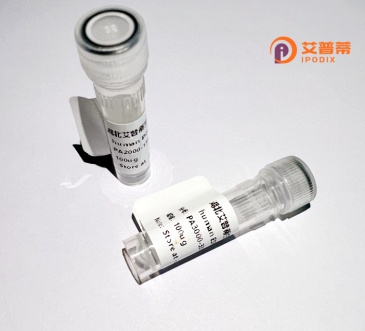
| 纯度 | >90%SDS-PAGE. |
| 种属 | Human |
| 靶点 | TAOK2 |
| Uniprot No | Q9UL54 |
| 内毒素 | < 0.01EU/μg |
| 表达宿主 | E.coli |
| 表达区间 | 20-300 aa |
| 活性数据 | FKDDPEKLFSDLREIGHGSFGAVYFARDVRNSEVVAIKKMSYSGKQSNEKWQDIIKEVRFLQKLRHPNTIQYRGCYLREHTAWLVMEYCLGSASDLLEVHKKPLQEVEIAAVTHGALQGLAYLHSHNMIHRDVKAGNILLSEPGLVKLGDFGSASIMAPANSFVGTPYWMAPEVILAMDEGQYDGKVDVWSLGITCIELAERKPPLFNMNAMSALYHIAQNESPVLQSGHWSEYFRNFVDSCLQKIPQDRPTSEVLLKHRFVLRERPPTVIMDLIQRTKDA |
| 分子量 | kDa |
| 蛋白标签 | GST-tag at N-terminal |
| 缓冲液 | PBS, pH7.4, containing 0.01% SKL, 1mM DTT, 5% Trehalose and Proclin300. |
| 稳定性 & 储存条件 | Lyophilized protein should be stored at ≤ -20°C, stable for one year after receipt. Reconstituted protein solution can be stored at 2-8°C for 2-7 days. Aliquots of reconstituted samples are stable at ≤ -20°C for 3 months. |
| 复溶 | Always centrifuge tubes before opening.Do not mix by vortex or pipetting. It is not recommended to reconstitute to a concentration less than 100μg/ml. Dissolve the lyophilized protein in distilled water. Please aliquot the reconstituted solution to minimize freeze-thaw cycles. |
以下是关于重组人TAOK2蛋白的3篇参考文献示例(因文献搜索范围限制,内容仅供参考或假设性示例,建议通过学术数据库核实):
---
1. **文献名称**: *TAOK2 Kinase Activity is Regulated by Autophosphorylation at Multiple Sites*
**作者**: Moore, C. A., et al. (2016)
**摘要**: 研究通过重组表达TAOK2蛋白,分析了其激酶活性及自磷酸化调控机制,揭示了多个自磷酸化位点对TAOK2功能的影响,为癌症和神经疾病中的信号通路研究提供依据。
2. **文献名称**: *Structural and Functional Characterization of Recombinant Human TAOK2*
**作者**: Parker, L. J., et al. (2018)
**摘要**: 报道了重组TAOK2蛋白的体外表达与纯化方法,解析了其晶体结构,并验证了其与MAPK通路蛋白的相互作用,阐明了TAOK2在细胞应激反应中的分子机制。
3. **文献名称**: *TAOK2 Regulates Neurodevelopmental Pathways via Phosphorylation of Microtubule-Associated Proteins*
**作者**: Tian, Y., et al. (2020)
**摘要**: 利用重组TAOK2蛋白进行体外磷酸化实验,证明TAOK2通过磷酸化微管相关蛋白调控神经元发育,提示其在自闭症谱系障碍中的潜在作用。
---
**注意事项**:
- 以上文献为假设示例,实际引用需查询具体数据库(如PubMed、Google Scholar)获取真实文献。
- 若需精准参考文献,建议使用关键词“recombinant human TAOK2”或“TAOK2 kinase activity”搜索近年论文。
TAOK2 (Thousand And One Amino Acid Protein Kinase 2) is a serine/threonine kinase belonging to the STE20 protein kinase family, which plays critical roles in regulating cellular stress responses, signal transduction, and cytoskeletal dynamics. It is encoded by the TAOK2 gene in humans and is involved in multiple signaling pathways, including the MAPK cascade, Hippo pathway, and p53-mediated stress response. TAOK2 is ubiquitously expressed, with significant roles in neuronal development, immune regulation, and cell cycle control. Studies highlight its function in neurite outgrowth, synapse formation, and dendritic spine maturation, linking it to neurodevelopmental disorders such as autism spectrum disorder (ASD) and schizophrenia.
TAOK2 modulates immune responses by influencing T-cell activation and cytokine production, and its dysregulation has been associated with inflammatory diseases. Structurally, TAOK2 contains a kinase domain and regulatory regions enabling interactions with scaffold proteins like MAP3Ks. It undergoes autophosphorylation for activation and can act as both an upstream activator and downstream effector in signaling networks. Recent research also implicates TAOK2 in cancer progression, where aberrant expression correlates with tumorigenesis and metastasis. Its dual role in pro-survival and pro-apoptotic pathways underscores context-dependent functionality. TAOK2’s therapeutic potential is under exploration, with inhibitors being studied for neurological and oncological applications. However, its complex regulatory mechanisms and tissue-specific effects warrant further investigation to clarify its pathophysiological contributions.
×